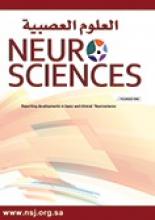Article Figures & Data
Tables
- Table 1
Demographic and clinical characteristics of ESUS patients with poor vs. favorable outcomes.
Characteristic Favorable outcome n=109 Poor outcome n=38 P-value n (%) Age (year) mean±SD 57.3±12.5 61.4±11.5 0.08 Female gender 36 (33) 14 (37) 0.7 Medical history Ischemic heart disease 7 (6.4) 3 (8) 0.72 Arterial hypertension 67 (61.5) 26 (68.4) 0.6 Diabetes mellitus 54 (49.5) 22 (58) 0.45 Dyslipidemia 28 (25.7) 8 (21.0) 0.7 Body mass index mean±SD 28±6.4 28.5±6.5 0.62 History of smoking 19 (17.4) 4 (10.5) 0.44 Previous ischemic stroke/TIA 20 (18.3) 9 (24) 0.5 Pre-stroke antiplatelet use 105 (96.3) 34 (89.4) 0.21 Pre-stroke mRS score* <2 102 (93.5) 30 (79.4) 0.04 NIHSS score† at admission median (IQR) 3.0 (5.00) 11.0 (10.0) <0.0001 Treatment with t-PA or EVT 5 (5) 4 (10.5) 0.24 ESUS - embolic stroke of undetermined source, EVT - endovascular treatment, IQR - interquartile range, mRS - modified Rankin Scale, NIHSS - National Institutes of Health Stroke Scale, TIA - transient ischemic attack, t-PA - tissue plasminogen activator.
↵* mRS scores range from 0 (no neurologic deficit) to 6 (death).
↵† NIHSS scores range from 0 (normal function) to 42 (death)
- Table 2
Multivariate logistic regression analysis of poor outcome (death or mRS score >2) at discharge.
Characteristic Odds ratio 95% CI P-value Age >60 years 2.4 [1.1,5.2] 0.02 Female gender 0.8 [0.4,1.8] 0.7 Body mass index >25 kg/m2 0.8 [0.35,1.8] 0.6 History of smoking 0.54 [0.17,1.71] 0.30 Ischemic heart disease 1.2 [0.3,5.1] 0.8 Arterial hypertension 1.4 [0.6,3] 0.44 Diabetes mellitus 1.4 [0.7,3] 0.4 Dyslipidemia 0.8 [0.3,2] 0.6 Previous ischemic stroke/TIA 1.4 [0.6,3.3] 0.5 Pre-stroke antiplatelet use 0.3 [0.1,1.4] 0.12 Pre-stroke mRS score (≥2) 4 [1.3,12] 0.01 NIHSS score at admission >5 12 [4.6,29.3] <0.0001 Treatment with t-PA or EVT 0.4 [0.1,1.6] 0.20 EVT - endovascular treatment, mRS - modified Rankin Scale, NIHSS - National Institutes of Health Stroke Scale, TIA - transient ischemic attack, tPA - tissue plasminogen activator






